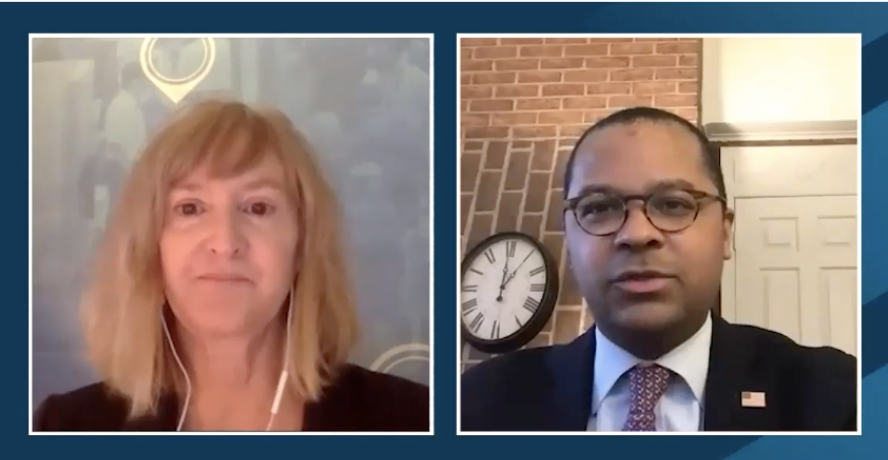This week, FCC Commissioner Geoffrey Starks spoke with Linda Hardesty of FierceWireless at the Fierce Wi-Fi Summit, highlighting all the benefits that opening the 6 GHz band for unlicensed use will have for Americans across the country. But before he even jumped into all the good the recently opened band has to offer, Starks emphasized that “with 6 GHz, Wi-Fi is really getting its biggest upgrade in nearly 20 years.”
Linda Hardesty of FierceWireless and FCC Commissioner Geoffrey Starks
We’ve come a long way in the nearly 40 years since unlicensed use began in the U.S. And in order to ensure Wi-Fi stays an “American success story,” as Commissioner Simington said last year, the 6 GHz upgrade is essential. The newly opened swath of spectrum will be particularly important with the current bands used for Wi-Fi—the 2.4 GHz and 5 GHz bands—becoming more and more congested over the past few years, which was only exacerbated by the pandemic.
Wi-Fi and unlicensed technologies are a major part of the U.S. and global economies. Even before the 6 GHz decision, Starks noted that “Wi-Fi has been estimated to contribute nearly $1.4 trillion to [the U.S.] economy.” In fact, the Consumer Technology Association (CTA) recently released a report estimating that unlicensed spectrum generates $95.8 billion per year, which is a massive increase from their $62 billion estimate in 2014. But Starks also went further, highlighting the importance of the Wi-Fi 6E market, saying “the 6 GHz decision will further accelerate the growth of Wi-Fi and its contribution to our economy,” with the Wi-Fi 6E market exploding as “more than 350 million Wi-Fi 6E devices will enter the market this year.”
And those devices utilizing the 6 GHz band won’t just boost our economy—they will also improve our Wi-Fi experience. As Starks pointed out, “Wi-Fi 6E will reduce congestion in the unlicensed bands and allow people to realize the full benefits of their home broadband connections in terms of increased speed, more connected devices [and] reduced latency.”
But the benefits of faster speeds and better connectivity aren’t just for those with new Wi-Fi 6E devices. “6 GHz and the impact on the digital divide is very clear that the 1,200 MHz of Wi-Fi spectrum will reduce congestion, increase speeds, increase the number of devices that can stream at the same time,” Starks emphasized. He later highlighted, “the impact on people who can’t afford those Wi-Fi 6E routers, computers—their speeds should increase as existing Wi-Fi traffic moves on to the new spectrum. So low-income consumers who are purchasing broadband plans, even through the Affordable Connectivity Program, should realize the full benefits of their subscription.”
While there are still a few hoops to jump through, Starks is confident the FCC can “get operations up and going by the end of 2022, so [Americans] can really realize the full value of this 6 GHz decision.”
The new capabilities the 6 GHz band will offer are a game-changing touchdown for Americans, and the momentum continues to grow. Starks ended by looking to the next play, Wi-Fi 7. The next generation of Wi-Fi “will be faster, [and] is expected to be roughly three times faster than Wi-Fi 6.” The future is bright for Wi-Fi and unlicensed spectrum, and we can’t wait to see how it all plays out.

